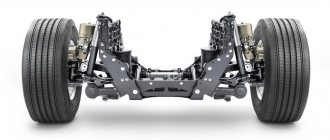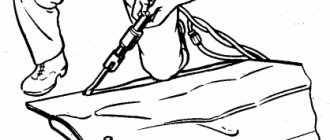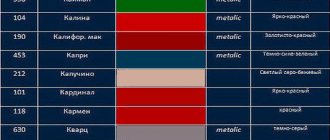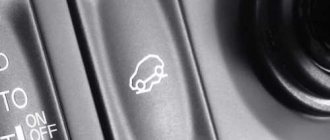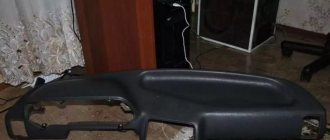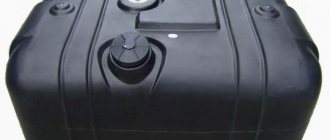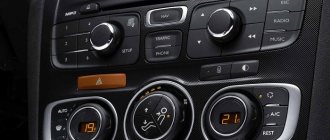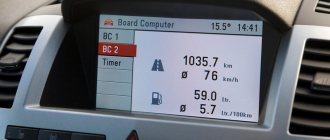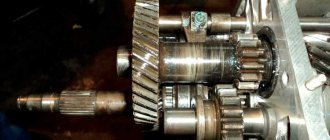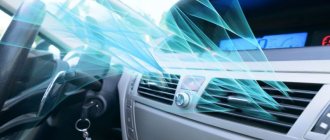Comments: no Published: 07/07/2017
Rating:
A car is a technically complex device consisting of a large number of parts, assemblies and mechanisms. Every self-respecting car owner is obliged to understand them, not even in order to be able to independently fix any malfunction that may arise on the road, but simply to understand the principle of operation of his car, and the ability to explain the essence of the problems that have arisen in a language understandable to a specialist. To do this, you need to know at least the basics, what main parts the car consists of, and what each part is called correctly.
See also:
Car muffler device
Car body
The basis of any car is its body, which is the body of the car that houses the driver, passengers and cargo. It is in the body that all other elements of the car are located. One of its main purposes is to protect the people and cargo in it from the influence of the external environment.
The supporting system of the car. It is the skeleton of the car, to which all the parts are subsequently attached.
Usually the body is attached to the frame, but there are also cars with a frameless design, and then the body simultaneously performs the functions of the frame. The car body structure is:
- single-volume, when the engine, passenger and cargo compartments are located in one volume (an example would be minivans or vans);
- two-volume, in which the engine compartment is provided, and places for passengers and cargo are combined in one volume (station wagons, hatchbacks, crossovers and SUVs);
- three-volume, where there are separate compartments for each part of the car body - cargo, passenger and engine (pick-ups, sedans and coupes).
Depending on the nature of the load, the body can have three types:
- carrier;
- semi-supporting;
- unloaded.
By the way, we would like to remind you that for cars and not only you can inexpensively buy interesting things on Aliexpress.
Most modern passenger cars have a supporting structure that absorbs all the loads acting on the car. The general structure of a passenger car body includes the following basic elements:
- spars, which are load-bearing beams in the form of a rectangular profile pipe, they are front, rear and roof spars;
Body load-bearing system. This system allows you to reduce the weight of the vehicle, lower the center of gravity, and therefore increase driving stability.
- pillars - structural elements that support the roof (front, rear and middle);
- beams and cross members, which are located at the roof, side members, under the engine mounts, and each row of seats, there is also a front cross member and a radiator cross member;
- thresholds and floors;
- wheel arches.
See also:
Car spar
The metal part of the body consists of the following body parts:
- Underbody (treated with anti-corrosion materials to reduce corrosion);
- Body roof;
- Body wings (treated with anti-corrosion materials to reduce corrosion);
- Body panels;
- Body doors (attached to the body pillars with hinges, which are held in place by screws, with the help of which the doors are adjusted vertically and horizontally); The door locks have a special design that prevents the door from opening even in the event of an accident.
- Body hood;
- Trunk lid.
Bumpers are installed at the front and rear of the body. On modern cars, bumpers are made of plastic or other similar materials. In the event of an accident, the car's bumper is the first to take the impact.
To accommodate the driver and passengers, seats are installed inside the car. Car seats are installed on special slides that allow you to adjust the seat in the longitudinal direction. You can also adjust the seat tilt, which is provided by special handles on the sides of the seats. The seat tilt can be adjusted until the bed is installed.
Recently, cars with hatchback and station wagon body styles have become very popular. This popularity is explained by the ability to transform the car into both a cargo and passenger version.
Car engine, its types
The heart of the car, its main component, is the engine. It is this part of the car that creates torque, which is transmitted to the wheels, causing the car to move in space. Today there are the following main types of car engines:
- ICE or internal combustion engine, which uses the energy of the fuel burned in its cylinders to produce mechanical energy;
- an electric motor powered by electrical energy from batteries or hydrogen cells (cars powered by hydrogen cells today are already available from most leading automakers as prototypes and are even in small-scale production);
- hybrid engines that combine an electric motor and an internal combustion engine in one unit, the connecting link between which is a generator.
It is a complex of mechanisms that convert the thermal energy of the fuel burning in its cylinders into mechanical energy.
By type of fuel burned, all internal combustion engines are divided into the following types:
- gasoline;
- diesel;
- gas;
- hydrogen, in which the fuel is liquid hydrogen (installed only on experimental models).
According to the design of internal combustion engines there are:
- piston;
- rotary piston;
- gas turbine.
See also:
Car vibrations: signs, causes and solution to the problem
What is a body type and its functions
The body is the main frame of the vehicle. The engine, gearbox and other elements are installed in it. Naturally, due to needs, the design often changes. On heavy vehicles, the load-bearing role is played by the frame, on which the body is mounted through rubber cushions. On frame cars, body elements act as a body that covers all important components for the vehicle, and also determines its appearance.
The body type determines most of the car's functions. It seriously affects the taxiing of the vehicle and the volume of interior space. Determines the type of activity of the car, for example, minivans are used to transport a large number of people, sports cars are for fast movement, and sedans perfectly serve as everyday cars.
Transmission
The main purpose of the transmission is to transfer torque from the engine crankshaft to the wheels. The elements of which it consists have the following names:
- A clutch, which is two friction discs pressed against each other, which connect the engine crankshaft to the gearbox shaft. This connection of the shafts of the two mechanisms is made detachable so that, by pressing the disks, it is possible to break the connection between the engine and the gearbox, to change gears and change the speed of rotation of the wheels.
This is a power transmission that connects the engine with the driving wheels of the car.
- Gearbox (or gearbox). This unit is used to change the speed and direction of movement of the car.
- A cardan transmission, which is a shaft with articulated joints at the ends, serves to transmit torque to the rear drive wheels. It is used only in rear-wheel drive and all-wheel drive vehicles.
- The main gear located on the drive axle of the vehicle. It transmits torque from the driveshaft to the axle shafts, changing the direction of rotation by 90°.
- A differential is a mechanism that serves to provide different rotation speeds of the right and left drive wheels when the car turns.
- Drive shafts or axle shafts are elements that transmit rotation to the wheels.
All-wheel drive vehicles have a transfer case that distributes rotation to both axles.
See also:
How does a car's air suspension work?
Frame
There are three types:
- Spar;
- Khrebtovaya;
- Spatial.
Within these species there are their own subspecies, and there are also mixed species. In this article, we will take a closer look at the classic spar frame:
Types of spar frames. Today we will only talk about the first one. Photo from the site https://techautoport.ru
The classic spar frame consists of two longitudinal spars and transverse beams. This type is often called a “ladder” type of frame. Currently, this type of frame is actively used in trucks and SUVs.
Chassis
The complex of mechanisms and parts that serve to move the car and dampen the resulting vibrations and vibrations is called the chassis. The chassis includes:
- the frame to which all other elements of the chassis are attached (in frameless cars, elements of the car body are used to attach them);
The chassis is a set of devices that interact with each other to move the vehicle along the road.
- wheels consisting of disks and tires;
- front and rear suspension, which serves to dampen vibrations that occur during movement, and can be spring, pneumatic, spring or torsion, depending on the damping elements used;
- axle beams that serve to install axle shafts and differentials; they are only available in cars with dependent suspension.
Most modern passenger cars have independent suspension and do not have axle beams.
Double volume
In a car with a two-volume body, the interior is in the same volume as the trunk. The trunk is most often very large and is shaped like a door with glass. The most common two-volume cars are liftback, station wagon, SUV, hatchback and crossover.
Station wagon
Station wagon is the most versatile and best-selling type of car in Europe. A station wagon most often has five doors. By transforming the interior, the already considerable trunk volume can be increased. To do this, just fold down the rear seats. Most cars with a station wagon layout are produced in the USA. The main advantage of these cars is the large trunk. Like a crossover, a station wagon can have all-wheel drive and increased ground clearance. Such vehicles are sometimes called all-terrain station wagons.
Hatchback
Today this type of car is becoming increasingly popular. This body type combines a large trunk volume of a station wagon and an attractive appearance. A hatchback is usually more compact than a sedan and station wagon, but its trunk volume is comparable to the latter. The rear door of this car has a slight slope. Like the station wagon, the hatchback can have the rear row of seats folded down to create a flat floor along with a significantly increased trunk volume. A hatchback is an excellent option for a car for every day; it is compact in size and at the same time functional; can transport cargo and look attractive.
Liftback
A liftback is a cross between a hatchback and a sedan. Typically, a liftback is the same size as a sedan, but its trunk lid, along with the glass, rises like a hatchback. This feature makes the car much more functional than a sedan.
SUV
In appearance, the SUV is similar to a station wagon or large crossover. Its main feature is the presence of all-wheel drive and increased ground clearance. The main purpose of off-road vehicles is to drive on bad roads and directions. An SUV usually has a frame, while a crossover most often does not have a frame.
Crossover
A crossover differs from an SUV in its smaller size and greater versatility. The crossover represents a compromise between a high level of cross-country ability and comfort when driving on regular roads. Today, city dwellers are increasingly buying crossovers to feel more confident on bad roads.
Steering
To move normally in a car, the driver needs to make turns, U-turns or detours, that is, deviate from straight-line movement, or simply control his car so that it does not drift to the side. For this purpose, its design provides steering control. This is one of the simplest mechanisms in a car. Let's look at the names of some of the elements below. The steering system consists of:
- steering wheel with steering column, this is the name of the ordinary shaft on which the steering wheel is rigidly mounted;
These devices consist of a steering system that is connected to the front wheels by steering and brakes.
- steering mechanism, consisting of a rack and pinion mounted on the steering column shaft, it converts the rotational movement of the steering wheel into translational movement of the rack in the horizontal plane;
- steering gear, which transmits the influence from the steering rack to the wheels to turn them, and includes side rods, a pendulum lever and wheel turning arms.
Modern cars use an additional element - power steering, which allows the driver to use less force to turn the steering wheel. It comes in the following types:
- mechanical;
- pneumatic booster;
- hydraulic;
- electric;
- combined electric hydraulic booster.
See also:
Roof rails for Lada Kalina car
Possible faults
For the manufacture of spars, only special aluminum or titanium alloys are used. The strength of the structure is very important, since the elements are subject to constant loads.
Over time, such exposure can lead to their deformation. During operation, microcracks may appear on the metal. This effect is often called metal fatigue. Damage, bends and cracks can affect changes in body geometry and many other parameters of the car. For example, the wheel alignment angles will change, an incorrect gap will appear when closing the doors, various kinds of squeaks in the cabin, and so on.
Also, these important elements can be deformed during an accident. These are the most common cases. Bending of the side members threatens serious repairs, or even complete disposal of the body. Cracks and gaps appear, and the geometry of the body is disrupted. In this case, it is unsafe to operate the car. Even repairs do not always give the desired result. Due to geometry violations, tire wear will most likely increase and the factory steering settings will be disrupted.
Deformation zone of side members
On the other hand, side members also belong to passive safety elements. They have zones of programmed deformation. In the event of an accident, the part will bend exactly in this place, taking away part of the impact energy.
Brake system
An important part of the machine that ensures safe driving is the braking system. Its main purpose is to forcefully stop a moving vehicle. It is also used when it is necessary to sharply reduce the speed of the car.
There are three options for the braking system: service, parking, spare.
The brake system comes in the following types according to the type of drive:
- mechanical;
- hydraulic;
- pneumatic;
- combined.
Modern passenger cars are equipped with a hydraulic brake system, which consists of the following elements:
- brake pedals;
- main hydraulic cylinder of the brake system;
- master cylinder filling tank for filling brake fluid;
- vacuum booster, not available in all models;
- front and rear brake piping systems;
- wheel brake cylinders;
- brake pads pressed by wheel cylinders to the wheel rim when braking a vehicle.
Brake pads are either disc or drum and have a return spring that presses them away from the wheel rim when the braking process is complete.
Electrical equipment, which is a set of electrical devices and devices that ensure normal engine operation
See also:
Car body types
Repair features
In most cases, problems with the front side members are addressed; the rear side members are not deformed so often. Bent elements are “pulled out”. This is done using a special installation. The difficulty also lies in the fact that you have to disassemble most of the car. Remove the engine, suspension elements, bodywork, etc. Not every master takes on such complex repairs.
If the spar has burst, but the main part is in good condition, then repairs can be done with welding work. In this case, it is worth keeping in mind that even after high-quality welding, it will no longer be possible to achieve the previous state of these elements. The strength will decrease precisely at the seam location. In frame structures, replacing these elements is much easier.
In some bodies, the side members are attached not by welding, but by brackets. This also makes repairs easier since it is easier to replace the part. But if the elements are severely damaged or bent, then there is often no point in repairing them.
Some drivers try to strengthen the side members in advance by adding additional stiffeners. In this case, you need to understand that the part loses its shock-absorbing properties.
Spars are one of the most important parts not only of the body, but of the entire car. They may be hidden in the depths of the body, but do not forget about their significance. They play a big role in the safety and controllability of the car. If these important elements become deformed, you should definitely contact a car repair shop to avoid possible costly repairs in the future.
Electrical equipment
One of the most complex systems of passenger cars with many different elements and wires connecting them, entangling the entire car body, is electrical equipment, which serves to provide electricity to all electrical devices and electronic systems. Electrical equipment includes the following devices and systems:
- battery;
- generator;
- ignition system;
- light optics and interior lighting system;
- drives for electric motors of fans, windshield wipers, window lifts and other devices;
- heated windows and interior;
- all electronics of the automatic transmission, on-board computer and protective systems (ABS, SRS), engine management and others;
- power steering;
- anti-theft alarm;
- sound signal.
This is an incomplete list of devices included in the electrical equipment of a car and consuming electricity.
Every driver needs to know the structure of the car body and all its components in order to always maintain the car in good condition.
Foam filler inside closed monocoque structures
The location of foam filler inside enclosed body structures may vary from vehicle to vehicle. Foam can be located in the sills, body pillars, and side members. Foam filler is used to reduce noise, vibration and increase body strength.
It is not advisable to weld panels near the place where the foam filler is located. If there is such a need, the filler must first be removed and then restored upon completion of the repair.
The foam filler does not melt or burn if you cut the part of the body next to it with a grinder.
It is not recommended to use construction foam to replace the special foam filler.
Basin (trunk floor)
In some cars, this container actually collects water, especially during the rainy season. It’s unlikely that you’ll be able to wash yourself in one, but it’s easy to spread corrosion. I think there is no need to explain where this element is located. Let me just show you a photo and you will understand everything:
The notorious "basin". Photo from Yandex.Pictures
Separate from the car - there really is a similarity, isn't it?)
After reading this article, you have reinforced your knowledge, and maybe learned something new for yourself.
Be sure to subscribe to us, like us and answer the question in the comments: what do you want to know about in the next articles?
Don't forget to fasten your seat belt. Taking care of your safety, DNA-AUTO.
See you in the next articles!
- Previous: Legal check of a car: what is it and how to check it yourself?
- Next: 2022 Hummer, better than the Cybertruck? -Yes
